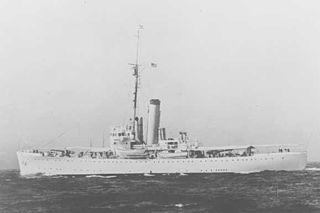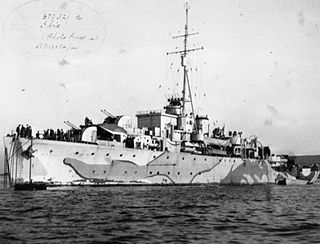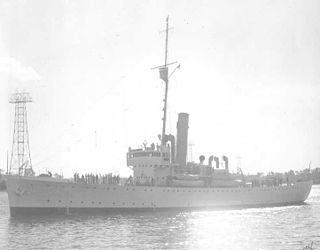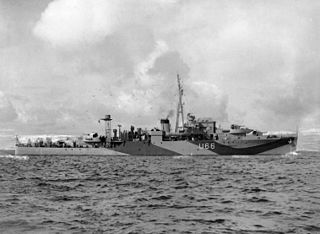 W
WHMS Actaeon was a modified Black Swan-class sloop of the Royal Navy. She was laid down by John I. Thornycroft & Company, Woolston, Southampton on 15 May 1944, and launched on 25 July 1945. The vessel was commissioned on 24 July 1946, with the pennant number U07.
 W
WHMS Amethyst was a modified Black Swan-class sloop of the Royal Navy. She was laid down by Alexander Stephen and Sons of Linthouse, Govan, Scotland on 25 March 1942, launched on 7 May 1943 and commissioned on 2 November 1943, with the pennant number U16. After the Second World War she was modified and redesignated as a frigate, and renumbered F116.
 W
WHMS Bideford was a Royal Navy Shoreham-class sloop. She was named after the town of Bideford in Devon and was launched on 1 April 1931.
 W
WHMS Black Swan, named after the black swan, was the name ship of the Black Swan-class sloops of the Royal Navy. This class was admired for its sea-going qualities.
 W
WUSCGC Cayuga (1932) was a Lake-class cutter of the United States Coast Guard launched on 7 October 1931 and commissioned on 22 March 1932. She was transferred to the Royal Navy where she served as HMS Totland (Y88), a Banff-class sloop from 1941 to 1946. After being returned to the USCG in 1946, she was recommissioned as USCGC Macoma 20 March 1947.
 W
WUSCGC Champlain (1929) was a Lake-class cutter of the United States Coast Guard, launched on 20 June 1928 and commissioned on 23 March 1929. After 12 years of service with the Coast Guard, she was transferred to the British Royal Navy as part of the Lend-Lease Act.
 W
WHMS Chanticleer was a modified Black Swan-class sloop of the Royal Navy. She was laid down by William Denny and Brothers, Dumbarton on 6 June 1941, launched on 24 September 1942 and commissioned on 29 March 1943, with the pennant number U05.
 W
WHMS Crane was a modified Black Swan-class sloop of the Royal Navy. She was laid down by William Denny and Brothers, Dumbarton on 13 June 1941, launched on 9 November 1942 and commissioned on 10 May 1943, with the pennant number U23. The saw active service during the Second World War, performing convoy escort roles in the Atlantic initially before supporting the Normandy landings. In the final months of the war, Crane joined the British Pacific Fleet with whom the vessel saw service during the Battle of Okinawa. Post war, Crane remained in south-east Asia and took part in hostilities during the Korean War. She was redeployed to the Middle East during the Suez Crisis before returning to Asia for service during the Malayan Emergency. Crane was withdrawn from service in the early 1960s and scrapped in 1965.
 W
WUSCGC Mendota (1928) was a Lake-class cutter belonging to the United States Coast Guard launched on 20 June 1928 and commissioned on 23 March 1929. After 12 years of service with the Coast Guard, she was transferred to the British Royal Navy as part of the Lend-Lease Act. She was sunk in January 1942 when struck by two torpedoes fired by the German submarine U-105.
 W
WHMS Cygnet was a modified Black Swan-class sloop of the Royal Navy. She was laid down by Cammell Laird, Birkenhead on 30 August 1941, launched on 28 July 1942 and commissioned on 1 December 1943, with the pennant number U38.
 W
WHMS Deptford was a Grimsby-class sloop of the British Royal Navy. Built at Chatham Dockyard in the 1930s, Deptford was launched in 1935 and commissioned later that year. The ship saw early service on the Persian Gulf station, but the outbreak of the Second World War saw Deptford serving as a convoy escort in the North Atlantic and the Mediterranean, sinking a German U-boat in 1941. She survived the war and was scrapped in 1948.
 W
WHMS Erne, pennant number U03, was a Black Swan-class sloop in the Royal Navy. She was laid down by Furness Shipbuilding at Haverton Hill-on-Tees, Co. Durham on 21 September 1939, launched on 5 August 1940 and commissioned on 3 April 1941. She was adopted by the district of Bootle, then in Lancashire, as part of Warship Week in 1942.
 W
WHMS Fleetwood was a Grimsby-class sloop of the Royal Navy. Built at Devonport Dockyard in the 1930s, Fleetwood was launched in March 1936 and commissioned in November that year. She served in the Red Sea until the outbreak of the Second World War. Fleetwood served as a convoy escort during the war, which she survived, and sank the German submarines U-528 and U-340. Post-war, the ship served as a radar training ship, remaining in use until 1959, when she was scrapped.
 W
WHMS Folkestone was a Hastings-class sloop of the Royal Navy that saw action in World War II. She was built by Swan Hunter and Wigham Richardson Ltd. of Wallsend-on-Tyne, laid down on 21 May 1929 and launched on 12 February 1930. She was commissioned on 25 June 1930 under the pennant number L22/U22.
 W
WHMS Fowey was a Shoreham-class sloop of the Royal Navy. She served during the Second World War.
 W
WHMS Grimsby was a sloop of the British Royal Navy, the lead ship of her class. Grimsby was built in the 1930s, entering service in 1934. Serving most of her pre-war service at Hong Kong, Grimsby was deployed on convoy escort duties along the East coast of the Britain and in the Mediterranean Sea during the Second World War, and was sunk by dive bombers off Tobruk on 25 May 1941.
 W
WHMS Hastings was a Hastings-class sloop of the Royal Navy that saw action in World War II. She was built by HM Dockyard Devonport, laid down on 29 July 1929 and launched on 10 April 1930. She was completed on 26 November 1930 and commissioned that same day by the Honourable Alice Brand. She is the sixth ship to bear the name HMS Hastings. Her pennant number was L27, but changed to U27 in May 1940.
 W
WHMS Hind was a modified Black Swan-class sloop of the Royal Navy. She was laid down by William Denny and Brothers, Dumbarton on 31 August 1942, launched on 30 September 1943 and commissioned on 11 April 1944, with the pennant number U39.
 W
WHMS Ibis, pennant number U99, was a Black Swan-class sloop of the Royal Navy, named after the Ibis.
 W
WUSCGC Itasca was a Lake-class cutter of the United States Coast Guard launched on 16 November 1929 and commissioned 12 July 1930. It acted as "picket ship" supporting Amelia Earhart's 1937 world flight attempt.
 W
WHMS Kite (U87) was a Modified Black Swan-class sloop of the Royal Navy, commanded by Lt Cdr Segram RN and once commanded by the famous U-boat hunter Captain Frederic John Walker. She was one of several ships of that class that took part in the famous "six in one trip" in 1944.
 W
WHMS Lapwing (U62) was a Modified Black Swan-class sloop of the Royal Navy.
 W
WHMS Lark was a modified Black Swan-class sloop of the Royal Navy. She was laid down by Scotts Shipbuilding and Engineering Company, Greenock on 5 May 1942, launched on 28 August 1943 and commissioned on 10 April 1944, with the pennant number U11.
 W
WHMS Leith was a Grimsby-class sloop of the Royal Navy that served in the Second World War.
 W
WHMS Londonderry was a Grimsby-class sloop of the Royal Navy. Built at Devonport Dockyard in the 1930s, Londonderry was launched in early 1935 and commissioned later that year. She served in the Red Sea and the South Atlantic until the outbreak of the Second World War. Londonderry served as a convoy escort during the war, which she survived. The ship was sold for scrap in 1948.
 W
WHMS Lowestoft was a Grimsby-class sloop of the Royal Navy. Built at Devonport Dockyard in the 1930s, Lowestoft was launched in 1934 and commissioned later that year. She served on the China Station, based at Hong Kong until the outbreak of the Second World War. Lowestoft served as a convoy escort during the war, both in the North Atlantic and off the west coast of Africa.
 W
WHMS Magpie, pennant number U82, was a Royal Navy Modified Black Swan-class sloop launched in 1943 and broken up in 1959. She was the seventh Royal Navy ship to bear the name. She was reclassified as a frigate in 1947, receiving a new pennant number F82. The ship was the only vessel commanded by Prince Philip, Duke of Edinburgh, who took command on 2 September 1950, when he was 29.
 W
WHMS Milford was a Shoreham-class sloop of the British Royal Navy. Milford was built at Devonport Dockyard in 1931–1932. Milford served during the Second World War, and was sold in 1949.
 W
WHMS Pelican (L86) was an Egret-class sloop, built for the British Royal Navy. She was active during the Second World War and was a successful anti-submarine warfare vessel, being credited with the destruction of four U-boats.
 W
WThe third HMS Penzance (L28) was a Hastings-class sloop launched in 1930, and torpedoed and sunk in 1940 whilst on convoy protection duty by the German submarine U-37 with the loss of 90 of her 104 crew. She was named after the Cornish port of Penzance and was the third Royal Navy ship to bear that name.
 W
WHMS Pheasant was a Modified Black Swan-class sloop of the Royal Navy. She was laid down by Yarrow Shipbuilders, in Scotstoun, Glasgow on 13 July 1942, launched on 21 December 1942, and commissioned on 12 May 1943. She was adopted by the rural district of Runcorn, then in Cheshire, as part of Warship Week in 1942.
 W
WUSCGC Pontchartrain (1928) was a Lake-class cutter belonging to the United States Coast Guard launched on 16 June 1928 and commissioned on 13 October 1928. After 13 years of service in the Coast Guard, she was transferred to the Royal Navy as part of the Lend-Lease Act. She was sunk in 1942 off Oran Harbor.
 W
WHMS Redpole was a modified Black Swan-class sloop of the Royal Navy. She was laid down by Yarrow Shipbuilders Limited, Scotstoun on 18 May 1942, launched on 25 February 1943 and commissioned on 24 June 1943, with the pennant number U69.
 W
WHMS Rochester (L50) was a Shoreham-class sloop of the Royal Navy. She served during the Second World War and was a successful anti-submarine warfare vessel, being credited with the destruction of five U-boats.
 W
WUSCGC Sebago (1930) was a Lake-class cutter belonging to the United States Coast Guard launched on 12 April 1930 and commissioned on 2 October 1930. After 11 years of service with the Coast Guard, she was transferred to the Royal Navy as part of the Lend-Lease to the Allies and became HMS Walney.
 W
WHMS Shoreham was the lead ship of the Shoreham-class of sloops built for the British Royal Navy. Completed in 1931, Shoreham served pre-war in the Persian Gulf. In the Second World War she served in the Gulf and Red Sea, the Mediterranean and the Indian Ocean. She survived the war and was sold for commercial use in 1946 and was scrapped in 1950.
 W
WHMS Starling, pennant number U66, was a Modified Black Swan-class sloop of the Royal Navy. She was active in the Battle of the Atlantic during the Second World War and was the most successful anti-submarine warfare vessel of the Royal Navy, being credited with the destruction of fourteen U-boats.
 W
WUSCGC Tahoe (1928) was a Lake-class cutter of the United States Coast Guard launched on 12 June 1928 and commissioned on 8 November 1928. After 13 years of service with the Coast Guard, she was transferred to the Royal Navy as part of the Lend-Lease Act.
 W
WHMS Wellington is a Grimsby-class sloop, formerly of the Royal Navy. During the Second World War, she served as a convoy escort ship in the North Atlantic. She is now moored alongside the Victoria Embankment, at Temple Pier, on the River Thames in London, England, as the headquarters ship of the Honourable Company of Master Mariners, where she is known as HQS Wellington. It was always the ambition of the founding members of the company to have a livery hall. Up to the outbreak of war in 1939, various proposals were examined, including the purchase of a sailing ship, Archibald Russell.
 W
WHMS Wild Goose, pennant number U45, was a Black Swan-class sloop of the Royal Navy. She was one of several ships of that class that took part in the famous "six in one trip" in 1943.
 W
WHMS Woodcock was built by Fairfields at Govan; laid down on 21 October 1941, launched on 26 November 1942, and completed 29 May 1943. She was the fifth Royal Naval vessel to carry this name.
 W
WHMS Woodpecker, pennant number U08, was a Black Swan-class sloop of the Royal Navy. She was active during the Second World War and was a successful anti-submarine warfare vessel, being credited with the destruction of six U-boats.
 W
WHMS Wren (U28) was a Black Swan-class sloop of the Royal Navy. She was active during the Second World War and was a successful anti-submarine warfare vessel, being credited with the destruction of five U-boats.